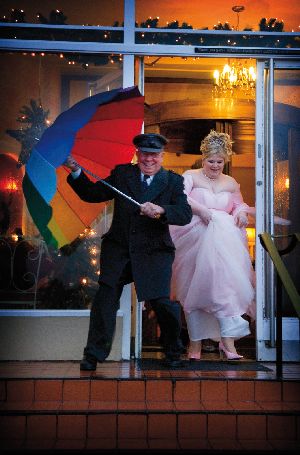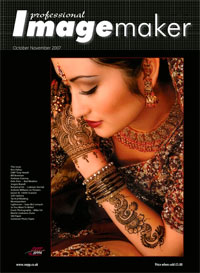articles/Weddings/badweatherwedding-page1
Coping with photographing bad weather weddings - part 1 of 1 2 3 4
Published 01/10/2007

By Peter Prior
Wedding photography is a challenging profession at the best of times. Not only do you have to be a half-decent photographer but you need to be able to react to events as they unfold, domineering officiants, deal with alterations to time schedules and, of course, be a good crowd manager.
Throw into the ring that you have no input into venue selection, time of year and day chosen, and, of course, the infamous British weather. Life is obviously a hell of a lot easier if you are shooting at a castle or stately home in good weather - better still if you have a decent amount of time to work with as well. Real life is rarely perfect and more often than not you will be confronted with a less than ideal location, wet and windy weather, and/or very little time to capture the images demanded by today's couples.
Producing consistently high-quality results is made even harder by the modern trend of 'photojournalistic wedding photography'. It seems that every man and his dog has a digital SLR and has set up as a 'reportage photographer'. Many newcomers to the industry have no real background knowledge or training in the techniques of lighting, posing or composition and in too many cases this can lead to problems when the photographer is confronted by less than ideal conditions.
I have had to help more than one photographer who has come a cropper when the conditions were challenging. In each case it was because they were booked as reportage photographers and had no real idea about how to photograph a wedding. Basically they set the camera to auto, machine-gunned away and hoped! When it came to working in poor light, rain or with a poor venue they were in trouble.
In my opinion the rise of reportage, combined with the cheapness of digital cameras, has made it easier than ever for newbies to come into the industry. However, their lack of technique and experience has cheapened the whole thing and too many can't produce when the going gets tough.
To my mind there is no substitute for good technique plus an understanding of lighting, composition and how a wedding will pan out. I feel I benefited from a great grounding through the original Guild of Wedding Photographers when it was run by Roy Doorbar and Ian Gee. Under the wing of a craftsman, John Bubb, I learnt these basic skills before I moved on to develop my own style.

How to cope with challenging conditions
There are a number of things you can do to try to make life easier. Obviously having the right equipment and knowing how to use it goes without saying. The 'right' equipment is not necessarily the latest and greatest camera.
I make sure I am always prepared for all eventualities. I carry spares of everything, make sure the batteries are all fully charged, lenses are clean and that, as far as I can tell, all of my equipment is functioning properly.
I have a 'prompt list' to keep me up to speed with how the day is going to evolve and this list includes notes taken from conversations with the couple about their requirements. I also have two or three plans in place about where and how I am going to take the pictures should the weather be unkind.
I can't stress enough how much easier the day will be if you have good communication with your clients. Find out what they really want, what they will feel comfortable doing and try to weigh up how they will react on the day. Building a relationship with the bride and groom always helps should the day turn out to be wet.
Basic preparation helps to make things easier on the day regardless of the time of year anyway but I'm surprised how many people don't seem to bother and then wonder why things go pear shaped....
Being organisedBride
The secret to being appreciated as a wedding photographer rather than hated is making sure you are organised and able to work quickly, without fuss on the day.
As mentioned earlier, I always work with a basic prompt list on the day regardless of whether I have met the couple beforehand or not. This year, two-thirds of my weddings were booked blind from recommendations and my website, and of those I hadn't met half of them before the wedding day!
I try to have a pre-wedding meeting with my clients to run through the day and discuss their ideas and requirements but, as I shoot all over the country this isn't always possible and practical. In this case, I insist on a telephone conference to make sure I am up to speed with their arrangements which helps avoid problems on the day or after the event.
Although I am known for my documentary approach to weddings, I understand that most have a 'formal element'. On average I shoot about eight groups and 10 minutes or so of bride and groom images at a wedding. The secret to making this go smoothly is to be organised, and know your equipment and what you are doing. Simplicity is key to speed for this part of the wedding coverage.
My clients appreciate the structured way in which I work as it means that groups take no longer than 10-15 minutes regardless of the conditions, time of year, etc. I start with the bridal party (best man, bridesmaids, ushers, etc) and then use one of the guys to act as my runner to collect other folks as they are required. This allows me to concentrate on getting the job done rather than wasting time wading into the crowd for Nan or Uncle Fred. I then build groups starting with the bride's parents, add the siblings, add the grandparent(s) and then finally any other family members, should they be required.
Next I do the same thing with the groom's family before taking a shot of any friends as a 'team photo'. If required I then shoot a big group to make sure everyone is covered without having to shoot endless line-ups.
You are currently on page 1
- Coping with photographing bad weather weddings page 1
- Coping with photographing bad weather weddings page 2
- Coping with photographing bad weather weddings page 3
- Coping with photographing bad weather weddings page 4
1st Published 01/10/2007
last update 09/12/2022 14:51:26
More Weddings Articles
There are 40 days to get ready for The Society of Photographers Convention and Trade Show at The Novotel London West, Hammersmith ...
which starts on Wednesday 14th January 2026





